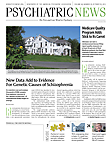Recent genomic discoveries are converging on several heritable risks that contribute to the development of schizophrenia. One such discovery arises from a new genomewide association study (GWAS) that identified 22 chromosomal regions with genetic variations that are linked to schizophrenia. Thirteen of these regions had not been identified before, while the rest confirmed findings of previous studies.
The multinational study, including researchers and funding from the United States, Sweden, and the Netherlands, was published online August 25 in Nature Genetics.
The single-nucleotide polymorphisms (SNPs) identified in this study cluster in four genetic regions (known as loci) that appear to harbor risk variations for schizophrenia: the calcium channel signaling pathway, which has already been implicated in psychotic disorders in a previous GWAS (Psychiatric News, April 5); areas on chromosome 6 that code for major histocompatibility complex (MHC), which plays a critical role in the immune system; the MIR137 gene coding for microRNA-137; and the long intergenic noncoding RNAs (lincRNAs), which are involved in the regulation of gene expression and epigenetics.
“This is still a tip of the iceberg,” Patrick Sullivan, M.D., a professor of genetics and psychiatry at the University of North Carolina School of Medicine, and the lead author of the study, told Psychiatric News.
Based on their analysis of genomes sampled from tens of thousands of patients and controls, the researchers estimated that approximately 6,000 to 10,000 independent SNPs contribute to at least one-third of the risk for schizophrenia. “There may be 1,000 genes involved,” said Sullivan. However, identifying 2,000 or so of the risk loci might be enough to reveal the biological processes that lead to schizophrenia, the researchers suggested.
“In this study, we describe concrete ways to discover more [risk] loci and deliver more robust results,” Sullivan noted. As more genomic data are collected from patients, and larger DNA chips are produced, it is only a matter of time before the genetic variants and, in turn, biological pathways surface.
Identifying key biological pathways of schizophrenia can open the door to more precise and successful methods for developing new treatments for the disorder. The researchers noted that clinical studies are already under way to test calcium channel blockers, commonly used for hypertension and heart disease, as a potential treatment for schizophrenia.
In addition, the study findings suggest that at least half, and perhaps most, of the genetic variations contributing to the risk of schizophrenia are common variants, meaning that they are widely inherited throughout the population. Although previous studies have discovered several rare variants and copy-number variants associated with schizophrenia, the data have convinced Sullivan that common variations probably play a predominant role.
Sullivan believes the analyses by his team suggest that schizophrenia is fundamentally similar to other “complex trait” characteristics and diseases, such as height, obesity, and cardiovascular diseases. Complex traits, in genetic terms, refer to phenotypes that result from variations within many genes and their interactions with the environment. Complex traits are not passed through generations in the pattern of Mendelian traits, caused by single-gene variations, such as those that cause Huntington’s disease.
“Genetics is really starting to deliver some ideas that will be very helpful in our understanding of schizophrenia,” Sullivan said. The rapidly growing GWAS data—more studies from larger samples are on the way—are finally illuminating the “genetic architecture” of schizophrenia.
Nevertheless, the role of nongenetic factors in the pathology of schizophrenia remains to be elucidated. The genetic evidence offers only a hint of the importance of the regulation of gene expression, which interacts with environmental triggers and stressors.
“The results of this mega-collaborative study by Sullivan and colleagues paint an even more complex mosaic than was previously appreciated,” APA President Jeffrey Lieberman, M.D., told Psychiatric News. “If confirmed, they will have a game-changing effect on our understanding of the genetics of mental illness.” He pointed out that the magnitude of SNPs estimated for schizophrenia, and possibly other mental disorders, could be larger than other complex-trait diseases, such as type 2 diabetes, coronary artery disease, and rheumatoid arthritis. “This is the genetic equivalent of death by a thousand cuts and shifts the focus from the rare mutations and CNVs that had previously been thought to be the predominant genetic mechanisms conferring disease risk.” Lieberman, who also is chair of psychiatry at Columbia University and director of the New York State Psychiatric Institute, agreed that the identified risk loci offer targets for new treatment development. ■
